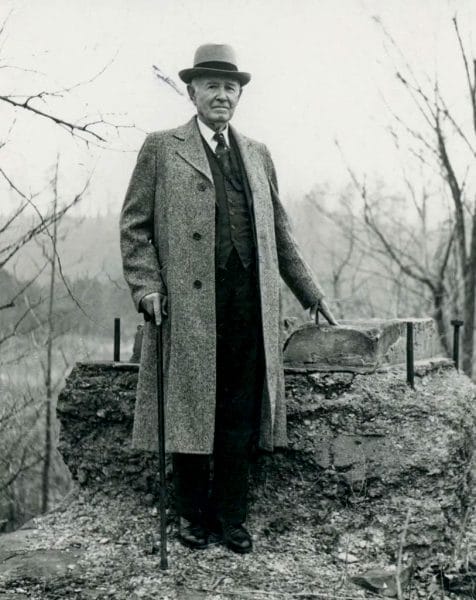Lay Dam and Lake
Lay Dam, located in Chilton and Coosa Counties near the town of Clanton, was the first hydroelectric plant built by Alabama Power Company. In service since 1914, this dam supplies hydroelectric power and fronts Lay Lake, a prime fishing and recreation destination in the state.
 William Patrick Lay
Gadsden native William Patrick Lay (1853–1940) had long been a proponent of developing the navigation and electrical potential of the Coosa River; on December 4, 1906, he organized the Alabama Power Company. His dream was to build a dam on the Coosa River at the Army Corps of Engineers’ Lock 12 site. Because the Coosa is considered a navigable stream, Lay had to obtain U.S. congressional approval to build a dam on the river. The bill he took to Congress had strong support from the Alabama congressional delegation, especially from John Lawson Burnett of Alabama’s 7th congressional district. The bill was passed by Congress and signed by Pres. Theodore Roosevelt on March 4, 1907.
William Patrick Lay
Gadsden native William Patrick Lay (1853–1940) had long been a proponent of developing the navigation and electrical potential of the Coosa River; on December 4, 1906, he organized the Alabama Power Company. His dream was to build a dam on the Coosa River at the Army Corps of Engineers’ Lock 12 site. Because the Coosa is considered a navigable stream, Lay had to obtain U.S. congressional approval to build a dam on the river. The bill he took to Congress had strong support from the Alabama congressional delegation, especially from John Lawson Burnett of Alabama’s 7th congressional district. The bill was passed by Congress and signed by Pres. Theodore Roosevelt on March 4, 1907.
With Alabama Power Company’s initial $5,000 and additional financial support from E. T. Schuler of Gadsden, Lay began purchasing land in the reservoir area and in 1910 started clearing the site. Unable to find additional financing to go forward, he was about to abandon the project when he met internationally connected electric power systems developer James Mitchell. With financing from London, Mitchell formed the Alabama Traction, Power & Light Company, a holding company to consolidate electric generation interests across the state. On May 1, 1912, Lay relinquished ownership in Alabama Power to Mitchell.
 Construction of Lay Dam
Mitchell selected Lay’s Lock 12 site to build the company’s first hydroelectric plant. Construction began in 1912. The isolated location required that housing for workers be constructed before work on the dam could begin. When completed, the workers’ village contained living facilities, an infirmary, churches, a school for workers’ children, a dining hall, and recreational facilities. As construction progressed on the dam, teams of workers cleared the reservoir area and transmission line rights of way. Because of its isolated location, very few local residents were displaced by the lake.
Construction of Lay Dam
Mitchell selected Lay’s Lock 12 site to build the company’s first hydroelectric plant. Construction began in 1912. The isolated location required that housing for workers be constructed before work on the dam could begin. When completed, the workers’ village contained living facilities, an infirmary, churches, a school for workers’ children, a dining hall, and recreational facilities. As construction progressed on the dam, teams of workers cleared the reservoir area and transmission line rights of way. Because of its isolated location, very few local residents were displaced by the lake.
The dam was completed on December 31, 1913, and went into service on April 12, 1914. The facility was called Lock 12 Dam until November 1929, when it was named in honor of Lay. After the dam was completed, as with other dams in the state, the dam operators and their families continued to live in the company village. Although the village had fewer residents, a guest house was maintained and a club house was added. For a small fee, other Alabama Power employees could catch a special train from Birmingham and spend weekends and vacation at the club house.
Two types of lakes are formed by Alabama Power’s hydroelectric plants: storage and “run-of-river.” On a storage lake, water levels vary seasonally. Power production is enhanced by maintaining water at the highest levels in the summer months when demand for electricity is greatest. Lake levels are lowered in the fall, usually reaching their lowest point in December to provide room for flood storage in anticipation of spring rains and to allow time for shoreline maintenance. Lay Lake, however, is a “run-of-river” lake, which means that lake levels remain fairly constant year round.
Lay Dam generates electricity only when peak demand for electricity requires it or when market prices for electricity are favorable. Usually hydroelectric power is the most economical way for Alabama Power to generate electricity because there are no fuel costs, but it cannot be used all of the time. During the drought of 2007, generation across Alabama Power’s system of dams, including Lay Dam, was reduced significantly. Electricity generated at Lay Dam is fed into the Southern Company power grid, and all customers draw their electrical power through substations connected to the grid.
All Alabama Power Company lakes are licensed by the federal government for a period of 30, 40, or 50 years. At the end of the licensing period, the company must reapply for a license. To be approved for relicensing, the company must demonstrate that it has satisfied the regulations set by the Federal Energy Regulatory Commission. These regulations, besides generation requirements, include minimum and maximum pool levels, flood control, environmental regulations, and provisions for recreation opportunities. The Army Corps of Engineers sets guidelines by which Alabama Power regulates its lake levels.
 Lay Lake Fishing
Lay Dam is a gravity concrete dam, which means that it is an entirely concrete structure. Falling water from the upstream side of the dam turns turbines that generate electricity. Lay Dam was renovated in 1967 as part of Alabama Power’s Coosa River development program. This redevelopment consisted of raising the height of the dam by 14 feet and making modifications to the powerhouse. Today, the structure is 2,260 feet long and stands 129.6 feet high. The powerhouse contains six generators, each producing 29,500 kilowatts of electricity. The lake formed by Lay Dam encompasses 12,000 acres, with a maximum depth at the dam of 88 feet. The watershed draining into the lake encompasses 9,087 square miles, and its total volume at full pool is approximately 86 billion gallons.
Lay Lake Fishing
Lay Dam is a gravity concrete dam, which means that it is an entirely concrete structure. Falling water from the upstream side of the dam turns turbines that generate electricity. Lay Dam was renovated in 1967 as part of Alabama Power’s Coosa River development program. This redevelopment consisted of raising the height of the dam by 14 feet and making modifications to the powerhouse. Today, the structure is 2,260 feet long and stands 129.6 feet high. The powerhouse contains six generators, each producing 29,500 kilowatts of electricity. The lake formed by Lay Dam encompasses 12,000 acres, with a maximum depth at the dam of 88 feet. The watershed draining into the lake encompasses 9,087 square miles, and its total volume at full pool is approximately 86 billion gallons.
Lay Lake provides 289 miles of shoreline and offers recreational opportunities for boating, fishing, swimming, and other outdoor activities. Boating ramps, picnic facilities, nature trails, and restrooms are available to the public. Lay Lake offers some of the best fishing in the South. Sport fish species include several varieties of bass, crappie, catfish, and sunfish. It is also home to the threatened Tulotoma snail (Tulotoma magnifica).
Further Reading
- Atkins, Leah Rawls. “Developed for the Service of Alabama:” The Centennial History of Alabama Power Company, 1906-2006. Birmingham: Alabama Power Company, 2006.
- Jackson, Harvey H. III. “Putting Loafing Streams to Work”: The Building of Lay, Mitchell, Martin, and Jordan Dams, 1910-1929. Tuscaloosa, Ala.: University of Alabama Press, 1997.



